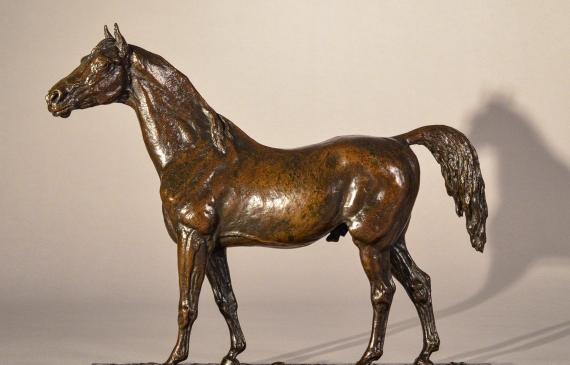
Christophe Fratin
French, 1801 – 1864
Rinbow – Cheval Arabe, 1835
Bronze, dark brown patina
12 1/8 H. x 14 1/2 W. x 4 3/4 D. inches
Signed: FRATIN in naturalistic base,
Stamped Underside: R
BRONZE MODEL OF “RINBOW – CHEVAL ARABE” BY CHRISTOPHE FRATIN
Patinated bronze, signed FRATIN in naturalistic base, cold-stamped R to underside; circa 1835
This model is referenced in Lami as Rinbow, étalon appartenant à M. Rieussec and was presented at the 1835 Paris Salon as no. 2253. It is pictured in Christopher Payne’s volume on animal bronzes (see below) where interestingly it has the same cold-stamped R to the underside as the model pictured in that volume.
A rich and incredibly rare work by Fratin, this very fine model of an Arabian Stallion is notable for the fluid textured surface captured in the bronze directly from the mold. It enjoys a translucent surface patina with an overall brown patination against black recesses and hints of red. Typical of his lifetime works, the model is remarkably crisp and has been executed to the highest of standards.
The reference to M. Rieussec may relate to the well-known and successful French watchmaker, Nicolas Mathieu Rieussec (July 20, 1781 – June 18, 1866).
Artist Listings & Bibliography:
Christophe Fratin was born in Metz on 1/1/1801 and died in Raincy, ( Seine-el-Oise ), on 8/16/1864. The son of a taxidermist, he began his studies of sculpture under Pioche. He was subsequently accepted as a student under Gericault, whose impasto technique was central to many of Fratin’s animalier sculptures.
Fratin first displayed the sculpture, Fermer, an English Thoroughbred at the Paris Salon in 1831, and regularly displayed thru 1842 and from 1851 to 1862. His bronze statuettes were edited, (cast ), using colleagues owned foundries to pour the bronze. Most of his early casts were edited at the workshop of Quesnels and later in life by the founder Daubre. Much of his work is in plaster, some produced by Susse Freres in the 1830s, as well as terracotta. Due to their delicacy, many did not survive.
Fratin was successful during his career, widely accepted during his lifetime, receiving private commissions, awards of exhibitions including several for public places in Paris. In 1851, at the Great Exhibition in England, he was awarded a medal as the greatest animal sculptor of his time. His Two Eagles and Prey have been in Central Park in New York since 1863. His distinct style can be contrasted with Barye or Mene’s anatomic detailing. As opposed to the classic animalier sculptors, Fratin’s work was often romantic – even humanized. In addition to sculpting animals in their natural habitats, he also is well known for sculptures of bears performing humorous tasks. The anthropomorphized style of his bears are in sharp contrast to his realistic sculptures. Some of his sculptures have a smooth and naturalistic finish. However, many of his works have a rugged finish, consistent with the impasto style he learned from Gericault. Such texturing makes light reflect off the sculptures adding unique three dimensional expressiveness.
Fratin was quite prolific. His sculptures are signed with his surname only using small hand – printed capitals or a three/quarter stamp. Occasionally the letter “N” is reversed. The foundry marks are stamp impressed. Fratin was a total individualist, with a distinct and imaginative style, often with finishes more consistent with a painter’s palette knife as opposed to a sculptor’s chisel.
Sources:
1. Dictionnaire critique et documentaire des Peintres, Sculpteurs et Graveurs, E. Benezit, 1956;
2. Bronze Sculptor of “Les Animaliers”, Jane Horswell, 1971;
3. Dr. Dave Welch, art historian